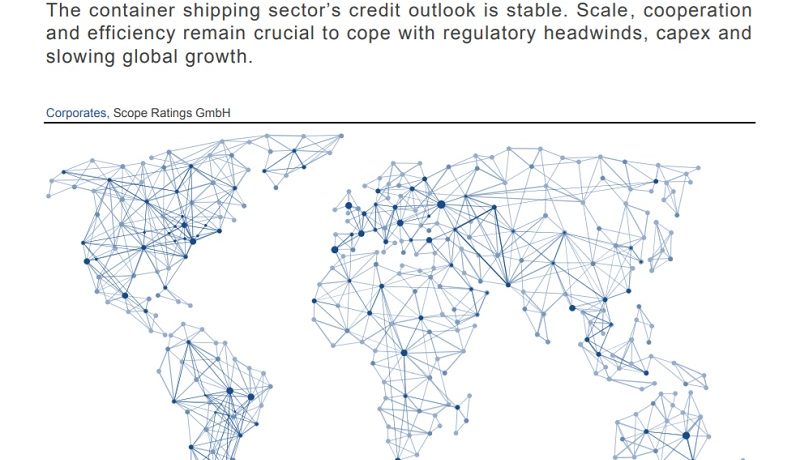Container shipping outlook 2020: credit quality stable; threats to seaborne trade volumes remain. The container shipping industry is sailing into less choppy waters in 2020: improved cost structures and greater economies of scale will help larger operators cope with regulatory headwinds, higher capital-expenditure, and slowing economic growth.
However, the gap in credit quality will continue to widen between the largest global operators which make up the three international shipping alliances1 and the rest of the industry. For the full report, please follow this link.
“The credit outlook for the container-shipping sector is stable – which is quite something for an industry which has been buffeted by excess shipping capacity, volatile fuel prices and freight rates in recent years,” says Denis Kuhn, analyst at Scope. “However, downside risks remain. Uncertainty over the credit outlook for 2020 hinges on the continued strength of global trade – the determinant of container-shipping volumes – in the context of slowing economic growth, notably in China where the recent coronavirus outbreak will have at least a short-term impact on imports, exports and economic activity,” (See Scope’s 31 January commentary: China: coronavirus outbreak’s longer-term policy side-effects more important than direct GDP impact).
The danger of a re-escalation of international trade disputes is another threat, notwithstanding the recent US-China agreement in their tariff battle.
Still, Kuhn says several trends are favouring container shipping operators in the year ahead:
– Higher-than-expected scrapping rates as the industry shifts to low-sulphur fuels should improve the problem of over-capacity.
– Spot freight rates will rise, given the uncertainty about shipping capacity, compared with average rates between 2016 and 2019.
– Growing economies of scale and efficiency will benefit the industry leaders as they take advantage of their international alliances.
– The defused US-China trade dispute may limit tariff-related disruptions to global supply chains though residual tensions between the world’s leading trading partners remain a risk.
At the same time, some of the more profound challenges the sector faces have not entirely disappeared, says Kuhn.
– Excess container-shipping capacity continues to weigh down on freight rates.
– Environmental costs are rising: from 1 January, operators have had to fit vessels with scrubbers to continue using high-sulphur fuel to meet new emissions standards or switch to more expensive ultra-low sulphur fuel.
– Operators, particularly smaller companies, will find it difficult to pass on higher, more volatile fuel costs and/or additional regulatory-related capex costs to customers.
“The crucial question for ship owners – regardless of which approach they adopt to meeting the new emissions standards – is to what extent they can pass on the additional cost of technical compliance to the end-customer,”
12M (Denmark’s Maersk Line and Swiss-based Mediterranean Shipping Co); Ocean Alliance (China’s COSCO and OOCL, France’s CMA CGM, Taiwan’s Evergreen); THE Alliance (Germany’s Hapag-Lloyd, Japan’s Ocean Network Express, Taiwan’s Yang Ming)
About Scope Ratings GmbH
Scope Ratings GmbH is part of the Scope Group with headquarters in Berlin and offices in Frankfurt, London, Madrid, Milan, Oslo and Paris. As the leading European credit rating agency, the company specialises in the analysis and ratings of financial institutions, corporates, structured finance, project finance and public finance. Scope Ratings offers a credit risk analysis that is opinion-driven, forward-looking and non-mechanistic, an approach which adds to a greater diversity of opinions for institutional investors. Scope Ratings is a credit rating agency registered in accordance with the EU rating regulation and operating in the European Union with ECAI status.

